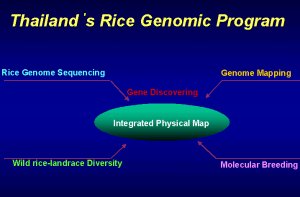จีโนมข้าวและการปรับปรุงพันธุ์ข้าวที่มีโภชนาการสูง
ผช.ดร.อภิชาติ
วรรณวิจิตร

Rice is
not only the grain for life but also a
model organism for large scale gene discovery.
Thailand has one of the most diversified
rice germplasm in the World. Extensive
identification and collection of genes
from the wild germplasm is the most effective
means to protect our diversity and prosperity.
The complete sequence of the genome will
provide a more direct route to uncover
genes en masse. An International Collaboration
for Sequencing the Rice Genome (ICSRG)
was established to completely sequence
the genome within 8 to 10 years. Among
cereals, rice has the most compact genome.
The genome size of 400 Mb is predicted
to have more than 30,000 genes expressed
differentially in space and time. We proposed
joining the ICSRG by sequencing 1 Mb annually
of chromosome 9 for the next five years.
The chromosome was selected based on our
previous extensive works on the fine genetic
and physical maps surrounding the submergence
tolerance QTL, the prospect of gene richness
and the small chromosome size. Such participation
will allow our scientists to directly
access the rest of the genome size. Such
participation will allow our scientists
to directly access the rest of the genome
sequence made available by the other collaborating
members. We also propose efficient ways
to utilize the genome sequence data for
gene discovery from wild rice germplasm.
The complete sequence data will be physically
linked to Khao Dawk Mali 105, the Thai
Jasmin rice. The complete physical map
based on BAC technology, extensive isolation
of high polymorphic molecular markers
and comprehensive genetic maps created
between the aromatic rice with valuable
landraces and wild rices are proposed.
Large and extensive collection of wild
rice and landrace germplasm and evaluation
schemes for responses to biotic and abiotic
stresses are also an important long-term
objective of this project. The gene-rich
wild species and landraces will be selected
for the construction of genetic and physical
maps, monosonic alien addition lines and
BAC libraries. Positional candidate gene
cloning approaches including the disease
resistance gene analog (RGAP) are proposed
as the most efficient way of directly
utilizing the sequence information for
gene identification. This project will
bring Thailand to international scientific
arena, incorporate state of the art technology,
and enhance the sustainability of rice
production. The ultimate outcome will
improve the competitive edge of Thailand
in the international rice market.

 Dr. Apichart
Vanavichit 1,2
1 Agricultural
Genetic Engineering and Biotechnology
Center, Kasetsart University, Kampangsaen,
Nakorn Pathom, Thailand, 73140
2 Agronomy
Department, Faculty of Agriculture, Kasetsart
University, Kampangsaen, Nakorn Pathom,
Thailand, 73140
Dr. Apichart
Vanavichit 1,2
1 Agricultural
Genetic Engineering and Biotechnology
Center, Kasetsart University, Kampangsaen,
Nakorn Pathom, Thailand, 73140
2 Agronomy
Department, Faculty of Agriculture, Kasetsart
University, Kampangsaen, Nakorn Pathom,
Thailand, 73140
|



